#gardening for climate change
Explore tagged Tumblr posts
Text
Golf Courses ARE Being Converted
The Solarpunk "fantasy" that so many of us tout as a dream vision, converting golf courses into ecological wonderlands, is being implemented across the USA according to this NYT article!
The article covers courses in Michigan, Pennsylvania, California, Colorado, and New York that are being bought and turned into habitat and hiking trails.

The article goes more into detail about how sand traps are being turned into sand boxes for kids, endangered local species are being planted, rocks for owl habitat are being installed, and that as these courses become wilder, they are creating more areas for biodiversity to thrive.
Most of the courses in transition are being bought by Local Land Trusts. Apparently the supply of golf courses in the USA is way over the demand, and many have been shut down since the early 2000s. While many are bought up and paved over, land Trusts have been able to buy several and turn them into what the communities want: public areas for people and wildlife. It does make a point to say that not every hold course location lends itself well to habitat for animals (but that doesn't mean it wouldn't make great housing!)
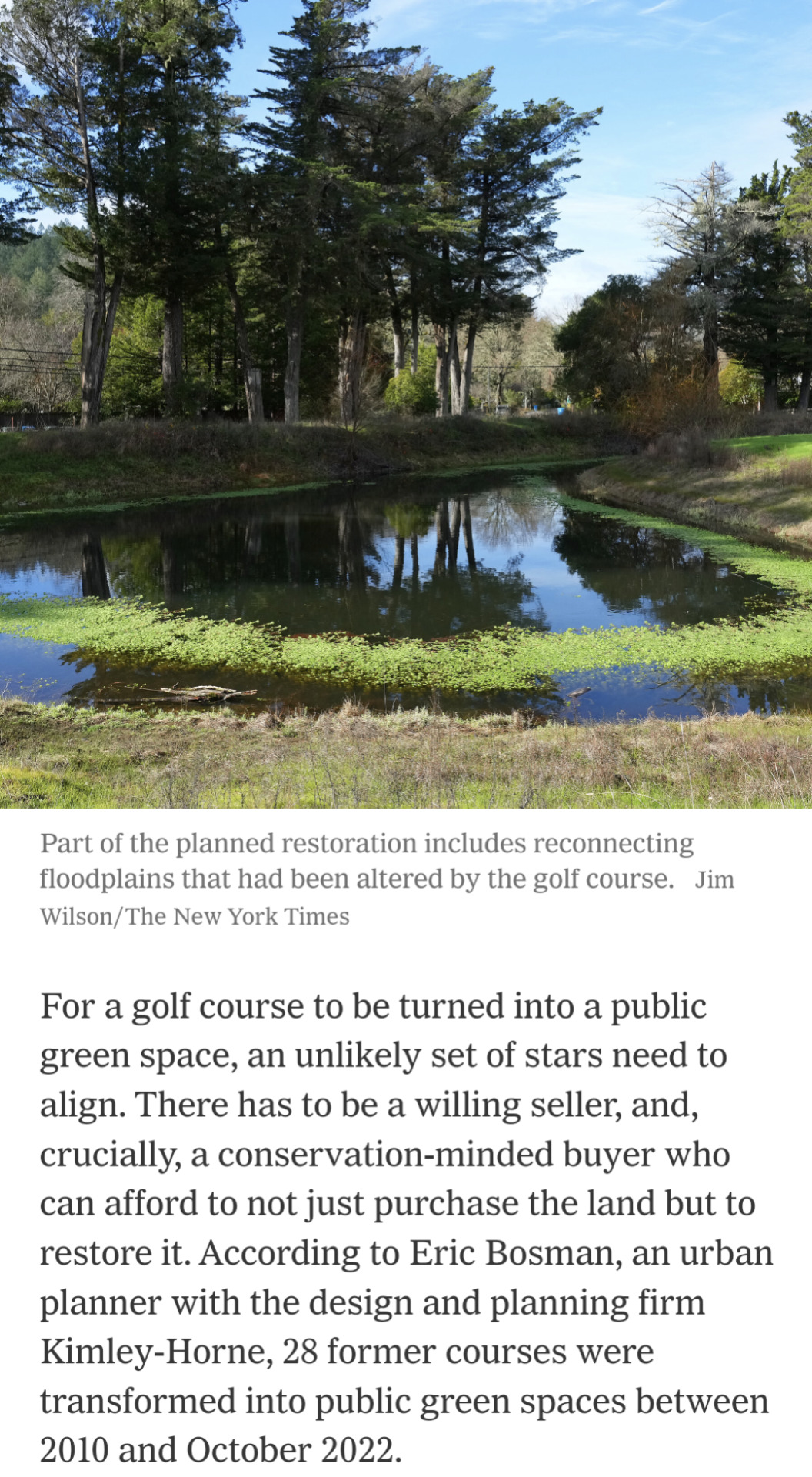
So lets be excited by the fact that people we don't even know about are working on the solutions we love to see! Turning a private space that needs thousands of gallons of water and fertilizer into an ecologically oriented public space is the future I want to see! I can say when I used to work in water conservation, we were getting a lot of clients that were golf courses that were interested in cutting their resource input, and they ended up planting a lot of natives! So even the golf courses that still operate could be making an effort.
So what I'd encourage you to do is see if there's any land or community trusts in your area, and see if you can get involved! Maybe even look into how to start one in your community! Through land trusts it's not always golf course conversions, but community gardens, solar fields, disaster adaptation, or low cost housing! (Here's a link to the first locator I found, but that doesn't mean if something isn't on here it doesn't exist in your area, do some digging!)
#solarpunk#sustainability#climate change#gardening#activism#hope#climate justice#news#new york times#golf courses#habitat#conservation
19K notes
·
View notes
Text
"Amsterdam’s roofs have just been converted into a giant sponge that will make the city more climate resilient.
The Dutch have always been famous for their ability to control water, born out of the necessity of their homeland, much of which is below sea level.
Now, their expert water management skills are transforming the city skyline in the capital city of Amsterdam from one of terracotta tile, concrete, and shingles into green grass and brown earth.
It’s part of a new climate-resiliency trend in architecture and civic planning known as the ‘sponge city concept,’ in which a garden of water-loving plants, mosses, and soil absorbs excess rainwater before feeding it into the building for use in flushing toilets or watering plants on the ground.
If heavy rains are predicted, a smart valve system empties the stored rainwater into the municipal storm drains and sewers in advance of the weather, allowing the roof to soak up water and reduce flooding in the city.
In this way, the rooftops of buildings can be wrung out and filled up just like a sponge.
In Amsterdam, 45,000 square meters, or 11 acres of flat metropolitan rooftops have already been fitted with these systems, and the contracting firms behind the technology say they make sense in dry climates like Spain just as much as in wet climates like Amsterdam...
A 4-year project of different firms and organizations called Resilio, the resilient network for smart climate adaptive rooftops, rolled out thousands of square meters of sponge city technology into new buildings. As with many climate technologies, the costs are high upfront but tend to result in savings from several expenditures like water utilities and water damage, over a long-enough time horizon...
All together, Amsterdam’s sponge capacity is over 120,000 gallons.
“We think the concept is applicable to many urban areas around the world,” Kasper Spaan from Waternet, Amsterdam’s public water management organization, told Wired Magazine. “In the south of Europe–Italy and Spain–where there are really drought-stressed areas, there’s new attention for rainwater catchment.”
Indeed the sponge city concept comes into a different shade when installed in drought-prone regions. Waters absorbed by rooftops during heavy rains can be used for municipal purposes to reduce pressure on underground aquifers or rivers, or be sweated out under the Sun’s rays which cools the interior of the building naturally.
Additionally, if solar panels were added on top of the rooftop garden, the evaporation would keep the panels cooler, which has been shown in other projects to improve their energy generation.
“Our philosophy in the end is not that on every roof, everything is possible,” says Spaan, “but that on every roof, something is possible.”
Matt Simon, reporting on the Resilio project for Wired, said succinctly that perhaps science fiction authors have missed the mark when it came to envisioning the city of the future, and that rather than being a glittering metropolis of glass, metal, and marble as smooth as a pannacotta, it will look an awful lot more like an enormous sculpture garden."
-via Good News Network, May 15, 2024
#amsterdam#netherlands#green roof#blue roof#city planning#urban#urban landscape#flood#climate change#climate action#climate emergency#climate hope#solarpunk#hope posting#go green#eco friendly#climate adaptation#sponge city#urban planning#good news#hope#rooftop garden
2K notes
·
View notes
Text
Good News - July 22-28
Like these weekly compilations? Tip me at $kaybarr1735 or check out my new(ly repurposed) Patreon!
1. Four new cheetah cubs born in Saudi Arabia after 40 years of extinction

“[T]he discovery of mummified cheetahs in caves […] which ranged in age from 4,000 to as recent as 120 years, proved that the animals […] once called [Saudi Arabia] home. The realisation kick-started the country’s Cheetah Conservation Program to bring back the cats to their historic Arabian range. […] Dr Mohammed Qurban, CEO of the NCW, said: […] “This motivates us to continue our efforts to restore and reintroduce cheetahs, guided by an integrated strategy designed in accordance with best international practices.””
2. In sub-Saharan Africa, ‘forgotten’ foods could boost climate resilience, nutrition

“[A study published in PNAS] examined “forgotten” crops that may help make sub-Saharan food systems more resilient, and more nutritious, as climate change makes it harder to grow [current staple crops.] [… The study identified 138 indigenous] food crops that were “relatively underresearched, underutilized, or underpromoted in an African context,” but which have the nutrient content and growing stability to support healthy diets and local economies in the region. […] In Eswatini, van Zonneveld and the World Vegetable Center are working with schools to introduce hardy, underutilized vegetables to their gardens, which have typically only grown beans and maize.”
3. Here's how $4 billion in government money is being spent to reduce climate pollution

“[New Orleans was awarded] nearly $50 million to help pay for installing solar on low to middle income homes [… and] plans to green up underserved areas with trees and build out its lackluster bike lane system to provide an alternative to cars. […] In Utah, $75 million will fund several measures from expanding electric vehicles to reducing methane emissions from oil and gas production. [… A] coalition of states led by North Carolina will look to store carbon in lands used for agriculture as well as natural places like wetlands, with more than $400 million. [… This funding is] “providing investments in communities, new jobs, cost savings for everyday Americans, improved air quality, … better health outcomes.””
4. From doom scrolling to hope scrolling: this week’s big Democratic vibe shift

“[Democrats] have been on an emotional rollercoaster for the past few weeks: from grim determination as Biden fought to hang on to his push for a second term, to outright exuberance after he stepped aside and Harris launched her campaign. […] In less than a week, the Harris campaign raised record-breaking sums and signed up more than 100,000 new volunteers[….] This honeymoon phase will end, said Democratic strategist Guy Cecil, warning the election will be a close race, despite this newfound exuberance in his party. [… But v]oters are saying they are excited to vote for Harris and not just against Trump. That’s new.”
5. Biodegradable luminescent polymers show promise for reducing electronic waste

“[A team of scientists discovered that a certain] chemical enables the recycling of [luminescent polymers] while maintaining high light-emitting functions. […] At the end of life, this new polymer can be degraded under either mild acidic conditions (near the pH of stomach acid) or relatively low heat treatment (> 410 F). The resulting materials can be isolated and remade into new materials for future applications. […] The researchers predict this new polymer can be applied to existing technologies, such as displays and medical imaging, and enable new applications […] such as cell phones and computer screens with continued testing.”
6. World’s Biggest Dam Removal Project to Open 420 Miles of Salmon Habitat this Fall

“Reconnecting the river will help salmon and steelhead populations survive a warming climate and [natural disasters….] In the long term, dam removal will significantly improve water quality in the Klamath. “Algae problems in the reservoirs behind the dams were so bad that the water was dangerous for contact […] and not drinkable,” says Fluvial Geomorphologist Brian Cluer. [… The project] will begin to reverse decades of habitat degradation, allow threatened salmon species to be resilient in the face of climate change, and restore tribal connections to their traditional food source.”
7. Biden-Harris Administration Awards $45.1 Million to Expand Mental Health and Substance Use Services Across the Lifespan
““Be it fostering wellness in young people, caring for the unhoused, facilitating treatment and more, this funding directly supports the needs of our neighbors,” said HHS Secretary Xavier Becerra. [The funding also supports] recovery and reentry services to adults in the criminal justice system who have a substance use disorder[… and clinics which] serve anyone who asks for help for mental health or substance use, regardless of their ability to pay.”
8. The World’s Rarest Crow Will Soon Fly Free on Maui

“[… In] the latest attempt to establish a wild crow population, biologists will investigate if this species can thrive on Maui, an island where it may have never lived before. Translocations outside of a species’ known historical range are rare in conservation work, but for a bird on the brink of extinction, it’s a necessary experiment: Scientists believe the crows will be safer from predators in a new locale—a main reason that past reintroduction attempts failed. […] As the release date approaches, the crows have already undergone extensive preparation for life in the wild. […] “We try to give them the respect that you would give if you were caring for someone’s elder.””
9. An optimist’s guide to the EV battery mining challenge
““Battery minerals have a tremendous benefit over oil, and that’s that you can reuse them.” [… T]he report’s authors found there’s evidence to suggest that [improvements in technology] and recycling have already helped limit demand for battery minerals in spite of this rapid growth — and that further improvements can reduce it even more. [… They] envision a scenario in which new mining for battery materials can basically stop by 2050, as battery recycling meets demand. In this fully realized circular battery economy, the world must extract a total of 125 million tons of battery minerals — a sum that, while hefty, is actually 17 times smaller than the oil currently harvested every year to fuel road transport.”
10. Peekaboo! A baby tree kangaroo debuts at the Bronx Zoo

“The tiny Matschie’s tree kangaroo […] was the third of its kind born at the Bronx Zoo since 2008. [… A] Bronx Zoo spokesperson said that the kangaroo's birth was significant for the network of zoos that aims to preserve genetic diversity among endangered animals. "It's a small population and because of that births are not very common," said Jessica Moody, curator of primates and small mammals at the Bronx Zoo[, …] adding that baby tree kangaroos are “possibly one of the cutest animals to have ever lived. They look like stuffed animals, it's amazing.””
July 15-21 news here | (all credit for images and written material can be found at the source linked; I don’t claim credit for anything but curating.)
#hopepunk#good news#cheetah#extinct species#africa#nutrition#food#farming#gardening#pollution#climate#climate change#climate crisis#democrats#us politics#us elections#kamala harris#voting#recycling#biodegradable#technology#salmon#habitat#fish#mental illness#mental health#substance abuse#hawaii#electric vehicles#zoo
847 notes
·
View notes
Text
LINK FEST: 7 FEBRUARY 2023
Links that may or may not be related to gardens, food, travel, nature, or heterotopias and liminal spaces but probably are. Sources in parentheses. essay: Hilarity in grief – #74 (Kelton Wright/Shangrilogs). On the loss of a cat, grief, chaos and cat-astrophe, and living in a haunted house. photo essay: The Flower That Sprouted From a Book (Boaz Frankel/Rootbound). “[H]ydrangeas and roses and…
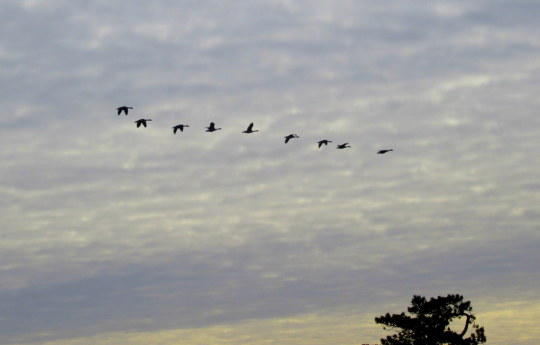
View On WordPress
#Alex Katz#Antarctica#art#art gallery#catastrophe#climate change#fire#flooding#gardening for climate change#grief#Guggenheim#habitat#linkfest#links#paper flowers#pet death#travel#Weather#winter
0 notes
Text
Vertical Greening Brings Nature to Urban ‘Heat Islands’ Quickly and Easily (LOOK) https://www.goodnewsnetwork.org/vertical-greening-brings-nature-to-urban-heat-islands-quickly-and-easily-look/
#good news#environmentalism#science#environment#nature#gardening#urban heat islands#urban design#climate change#climate crisis#climate adaptation
617 notes
·
View notes
Text
for people who can't click into the article right now, this is about the standard plant hardiness zone chart all people who garden in america are familiar with, and the way it has shifted the as climate change ramps up.
627 notes
·
View notes
Text

College Programs of the Near Future.
And more from the future.
#college#future#education#google#medicine#heat#climate change#apocalypse#emoji#linguistics#gardening#underground
78 notes
·
View notes
Text
*casually posts this at the same time to further my agenda of growing native plants instead of grass and shitty ornamentals*
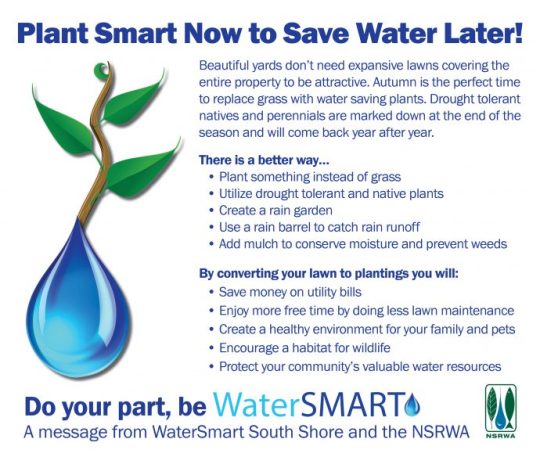


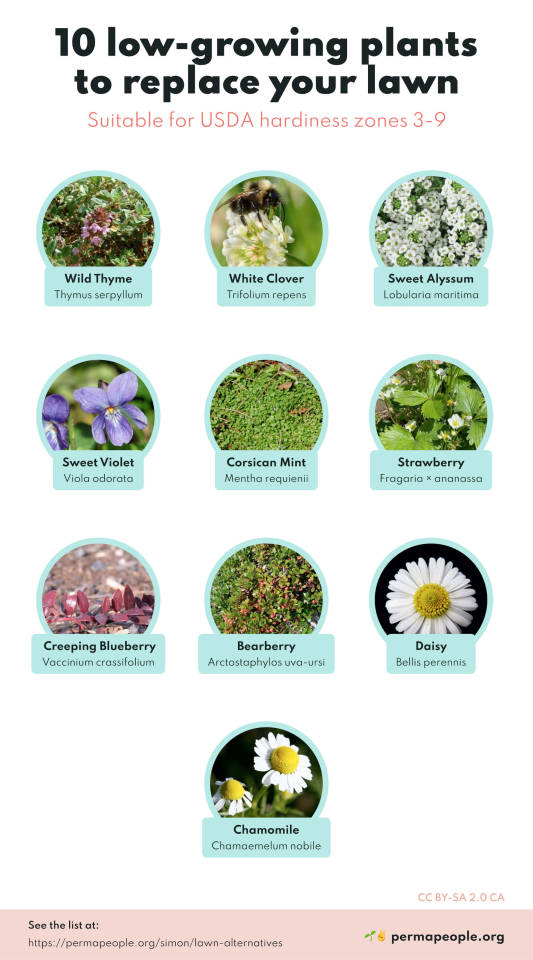
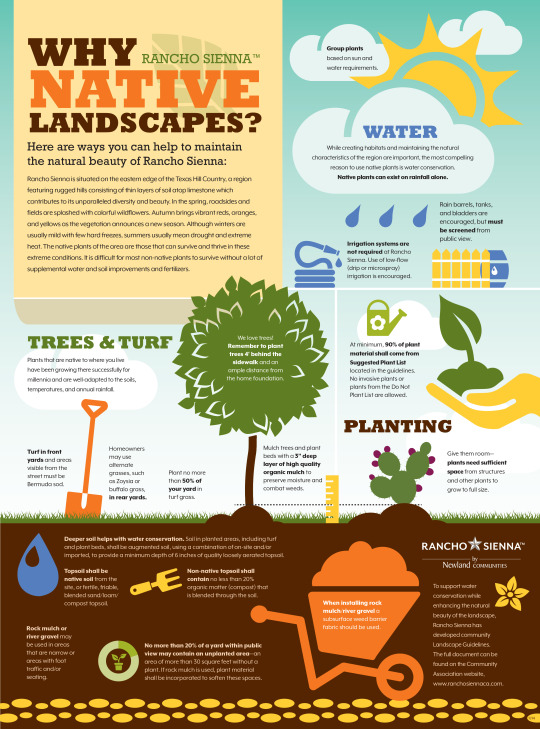


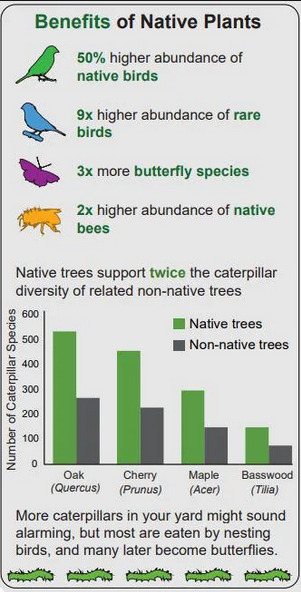

#gardening#water conservation#biodiversity#kill your lawn#native plants#native pollinators#pollinator garden#climate change#sustainability#environmental rehabilitation#habitat restoration#wildflowers#native flowers#animals#water crisis#didnt mean to post that grass one whoops. i think i skimmed it and wasnt thinking about it too much#but ig its true grass would be better than roads. lets just uh. make it native grass yaknow?
293 notes
·
View notes
Text
So, I've been reading 'Seeds of Hope' by Jane Goodall, because I am curious to what other people are saying about plants, and this book truly delivered. I've been introduced to some past plant drama in the world and that was incredible lore that should have been taught in history.
Apparently, when people first discovered tulips, they were so intensely valuable and popular, that people would trade huge amounts of money, diamonds, or even acres of land, for just one bulb. People were pre-paying for bulbs that didn't even exist yet, they would pre-order bulbs that are not yet even made. One servant ate a bulb thinking it was an onion and he got jail time for it. And I mean they're all correct, tulips just are that good.
There was also a lot of, much sadder drama about orchids; I didn't know this, but they originally grow very high up in the trees, and people were competing for discovering new and rare species. These rare and exotic species would then be displayed in rich people's gardens. Because they became so valuable, poachers would go trough the forests and take almost all of the orchids in there, making them near extinct in nature. This was resolved by orchid gardeners carefully growing them, multiplying and sharing to the point where they were sold commercially, which lessened their value on the black market, so there was no need to pillage them from the forests anymore. Growing rare plants is protection of them!
The book goes on to talk about botanic gardens, herbariums, and the value of collecting and archiving plant material, which is then showing us the effects of climate change, and stores valuable information about what is happening to the plants. It made me want to start a herbarium for sure, I'm always stressed about the loss of local plants, and it's happening more and more as green areas are cleared out.
The book touches upon plants that people have found harmful, such as plants that people make drugs out of; she clears it out to us that these plants are sacred to the native people who grew up with them, and creating drugs from them is in fact, abuse of these plants, and offensive to the communities who hold them sacred, and use them in appropriate doses as medicine. The book talks a lot about plant medicine! Apparently the pharmacy companies have been learning the knowledge about medicinal plants from native people who knew how to use plant medicine, and then the pharmacy would make medicine from those same plants, and profit off of it, without giving any credit or profit to the communities they got this knowledge from, which is not great. But then the demand for this medicine would go so high, they would go and gather all, or almost all medicinal plants from the areas where native people lived, devastating their medical supplies and natural habitats. Book goes on to question the ethics of acquiring medicine in this way, and never informing people where it came from, or what was sacrifices in order for the world to have it.
Similar things happened with valuable crops that are grown in native areas; once the demand for these crops grew, big monocrop fields were established, damaging the land and the local ecosystem, killing millions of animals who lived there, and sometimes forcing people or children into modern slavery, in order to grow them. Coffee, cocoa beans, vanilla beans, palm oil; they've been described as specifically devastating for the communities and the environment. But the book doesn't condemn these foods at all, instead the author goes on to describe, what has been done to improve this. Instead of monocrops, which are devastating for the environment, people are now taught to grow fruit trees in the same fields as coffee, which makes the coffee plants healthier and stronger, and creates and environment where some plants and animals can thrive. I personally don't believe you should have only 2 or 3 plants in a big area, I think you need about 3 millions, but it's a progress from monocrops.
The author describes finding and helping the local farmers who found ways to healthy, natural and non-damaging growing of these plants, and she helped them sell it! She also encourages buying organic food because it helps if the demand for non-monocrop food is growing.
Now there's a section of the book standing strongly against GMO foods, and for some reason I never heard any arguments against gmo, I didn't understand much about the harm coming from them, so I was very curious to hear this. The author explained how 47 million dollars was spent just for lobbying for GMO, which explains why all my information on gmo was positive, and I remember hearing it was 'the best way to reduce world hunger', but the world hunger is still a problem, so it obviously did not succeed. But now I have a better understanding of what it is.
GMO foods were specifically developed to have pesticides inside of them, so they'd be poisonous to pests, but not to people eating them. The research on whether they're poisonous to animals showed that the animals who ate them long term, had their inner organs irritated, enlarged, stomach infections, and had higher risk of cancer. So it was not proven to be safe, but it ended up in the stores anyway; the author says that about 70% of food in american supermarkets has unlabelled gmo, which is scary to think about. She also explains that this is the reason so many people in america are now trying to grow food at home, they don't want to be poisoned by pesticides.
GMO foods were specifically designed to support monocrops, and to protect them pests; this worked out in creating more and more bugs that are resistant to the pesticides, and farmers have reported the appearance of 'superbugs', which are resistant to any kind of pesticide. There's now also 'superweeds', which are resistant to herbicide. The industry is trying to develop new pesticides and new herbicides, in order to counter these new problems, but it is obvious that they're only sinking deeper and deeper; monocrops are unsustainable. Poisoning the earth and the plants, and even the seeds, is not going to lead to the end of world hunger. Farmers are often ending up losing their entire farms due to new bugs that are now thriving because all of their competition has been eliminated by pesticides, they're now the only bug and they can eat up the entire crop easily.
The other problem of GMO crops is that they're spreading their seeds and mixing with the natural crops, making them into GMO crops as well. According to the author the canola crops has already been lost, now all canola existing is genetically modified.
I'm dissatisfied with this knowledge, but it's better to know and be aware rather than to be in the dark. The author suggests designing living spaces that have gardens in them, and encouraging local community to garden, as well as planting city gardens, where food would grow for everyone. She goes on to describe the efforts of universities and cities who already had built their own living gardens in order to support the community, and how it worked to create a more beautiful, life-sustaining, happier place. She even explained how having local gardens makes the crime rate lower.
I loved this book, it had the environment awareness that can only be compared to Greta Thunberg's book, it described trees and plants so lovingly, and the connection people have with them. It showed me there's so many people fighting to save the forests and grasslands and native plants, and it's an effort that will make a big difference to how we get to live on this planet in the future.
#jane goodall#seeds of hope#book review#reading#environmentalism#climate change#gmo#gmo foods#monocrops#gardening#environmental
66 notes
·
View notes
Text

II
“We are being led to our slaughter. This has been theorized in a thousand ways, described in environmental, social, and political terms, it has been prophesied, abstracted, and narrated in real time, and still we are unsure of what to do with it. The underlying point is that the progress of society has nothing to offer us and everything to take away. Often it feels like we are giving it away without a fight: when we sell our time for money, allow our passions to be commodified, invest ourselves in the betterment of society, or sustain ourselves on the spoils of ecological destruction, we openly (though not consensually) participate in our own destruction.” — Serafinski, Blessed is the Flame, An introduction to concentration camp resistance and anarcho-nihilism
Civilizations’ death culture of accumulation, exploitation and consumerism, at whatever the cost is at its final stages spreading war and ecocide to every corner of the globe.
It has turned individuals into consumerist herds of wage slaves making us all addicted to some degree or other waiting for the false promises that will never be delivered for most.
How many individuals do actually want to work? I know I don’t. How many actually find pleasure in it having to repeat day after day, after day? Or have to give up on achieving their dreams, or sell themselves in the hope of reaching them?
This is the culture which creates the conditions of refugees fleeing the carnage of war having to walk across a continent to find safety, a better life for themselves and their family all the while begrudging fools would rather see them drown in the medaterian sea along with their children on dinghies so packed with desperate individuals it sinks.
While taking part in solidarity projects I’ve seen mothers in France having to live in muddy fields infested with rats, flimsy tents as protection from the elements. Small groups huddle around fires trying to catch some heat. Babies cries can be heard across the camp. I’ve seen the muddy swamp-like trails that weave through the refugee camp full of rat footprints and urine which appear each morning after the night’s darkness has gone. The very same conditions a 100 years earlier, as the first world war raged on, in the exact same location individuals from lower classes fought it out, blowing each other to smiderians all so wealthier classes could expand their riches!
This is the same culture which creates the conditions for a homeless crisis and makes it socially acceptable for individuals to be left to freeze to death on streets in shop doorways in Dublin’s city centre. I’ve seen the tent cities, the ques of soup kitchens, the desperate.
Society finds this all morally acceptable.The contradiction of civilization couldn’t be any clearer, on the one hand there is riches and wealth beyond beleaf and on the other hand there is poverty and exploitation inflicted beyond comprehension. This is the land of despair, cruelty, and greed.
#subsistence gardening#gardening#resistance#solarpunk#gardening as resistance#small farms#small farm movement#community building#practical anarchy#practical anarchism#anarchist society#practical#revolution#anarchism#daily posts#communism#anti capitalist#anti capitalism#late stage capitalism#organization#grassroots#grass roots#anarchists#libraries#leftism#social issues#economy#economics#climate change#climate crisis
54 notes
·
View notes
Text
Use this handy app to learn how climate change impacts you personally, where you live. All you have to do is enter your city & state.
USA citizens only, alas.
46 notes
·
View notes
Text
One of the (many) important reasons that so many climate solutions stress organizing or joining a group centered in sustainability is so that bad days are supported.
There's a day animals get into your flowers and tear them up, or a tool breaks, or a conversation with someone about climate goes real sour, or news on the planet's health gets to you, however your hope is diminished, other people who get it can help out. They can create a support, or, even better, supportive redundancy.
Having others who "get it" means that they can listen on a level that you feel heard, or give you advice, or just calming words. Recently I was struggling with how long it takes to develop community-led urban resilience projects, spiraling into dark places, when my friend just said, "hey, lemme tell you about a community microgrid in my hometown" and hearing a success helped immensely.
Whenever I see people here on Tumblr post their garden yields, or their new zine, whenever my friend vents about her new roadblock in a climate change lawsuit she's helping with, whenever someone in my sustainability gc talks about their agreement with the mayor for native plant seeding in public tree lawns, it makes my day.
Progress doesn't feel like progress every day, sometimes it feels an awful lot like regression, and right now so many awful things are happening in the world, any support can feel revolutionary. Find people, share with them, listen well. Feel supported. Give support. We're in this together.
672 notes
·
View notes
Text
"A recent World Meteorological Organization report called heat waves the “deadliest meteorological hazard” from 2015 to 2019, affecting people living on all continents, and setting new national heat records in many regions.
Canada’s top weather event in 2021 was British Columbia’s record-breaking heat, according to Environment and Climate Change Canada. The temperature in Lytton, B.C., hit 49.6 C on June 29. The following day a wildfire destroyed 90 per cent of the town, killing two people and displacing 1,200 others.
Heat waves also exacerbate existing health issues, including cardiovascular and respiratory disease. They’re associated with increased hospital admissions, psychological stress and aggressive behavior, as well as excess mortality.
During heat waves, the highest temperatures are often found in urbanized areas. Urbanization is almost always associated with an increase in paved, impervious areas, and often a decrease in greenery. Concrete and asphalt roads, and other built materials readily absorb, store and release heat, raising city temperatures, a phenomenon called the urban heat island.
Many studies have shown that urban forests can reduce the urban heat island, and many policies focus their attention on large green spaces.
Small green spaces, such as yards, rooftops and small parcels of undeveloped land, can make impressive contributions to lowering urban heat, but they are often overlooked when developing strategies for urban cooling.
The effect of small green spaces
Cities rarely have the opportunity to add large green spaces to help counter the effects of heatwaves. Smaller vegetated spaces, however, can still meaningfully decrease local land temperatures.
Small green spaces, such as yards, rooftops and small parcels of undeveloped land, can make impressive contributions to lowering urban heat, but they are often overlooked when developing strategies for urban cooling.
A recent study in Adelaide, Australia, found that tree canopy cover and, to a lesser extent, grass cover decreased local daytime surface temperatures by up to 6 C during extreme summer heat conditions. Further inland, suburban yards and gardens can decrease local surface temperatures up to 5 C.
At a quite small scale, on the order of tens of square metres, trees reduced daytime surface temperatures twice as much as grass cover. But grass and other small, low-lying plants, grow relatively quickly, compared to trees.
Cities should adopt short-term and long-term strategies to respond to extreme heat, including the replacement of paved and impervious surfaces with grasses and turf, and increasing tree plantings to boost canopy coverage.
Amplifying the cooling effect
Furthermore, when managing small green spaces, city planners and foresters can select tree species based on their ability to cool the environment. Green spaces with a high diversity of tree species have a greater cooling effect in spring, summer and fall. They also have a larger maximum drop in temperature in the summer, compared to spaces that are less diverse.
For example, tree canopies with large leaves and high transpiration rates — the evaporation of water from plants occurring at the leaves — could provide more cooling.
Planting a variety of species, of different heights, can have a larger cooling effect than tall trees alone.
The structure of green space may also influence its cooling efficiency. In summer, a plant community with multiple layers of trees, shrubs and herbs can further decrease air temperature by 1 C on a sunny day and 0.5 C on a cloudy day, compared with an area only dominated by tall trees...
But overall, trees usually have a stronger effect on cooling than grass. Planting trees in groups, not individually or in lines, is recommended for regulating the microclimate (local climate conditions near the Earth’s surface).
Small green spaces can offer a lot of summer cooling in cities. And cities can learn to manage the configuration of small green spaces better to get more cooling benefits and minimize the trade-offs."
-via GoodGoodGood, July 4, 2024
#green space#urban#urban landscape#urban forest#urban green spaces#food forest#permaculture#gardening#microclimate#cooling#conversation#global warming#climate change#climate action#solarpunk#rooftop garden#ecopunk#meterology#ecology#ecosystems#environmental science#plant trees#good news#hope
715 notes
·
View notes
Text
Good News - May 22-28
Like these weekly compilations? Support me on Ko-fi or $Kaybarr1735! Also, if you tip me on Ko-fi or CashApp (and give me some way to contact you if it doesn’t automatically), at the end of the month I'll send you a link to all of the articles I found but didn't use each week - almost double the content!
1. Scientists Invent Healthier More Sustainable Chocolate
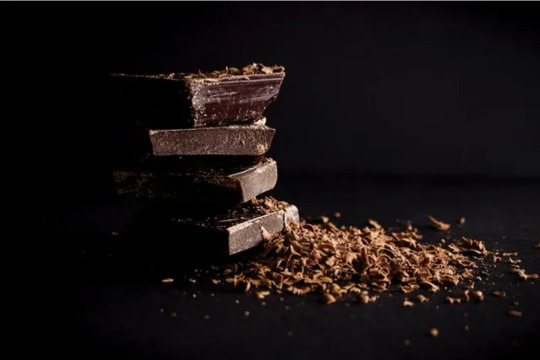
“The new chocolate recipe from researchers at ETH Zurich uses more materials from the cocoa pod that are usually discarded, including more of the pulp as well as the inner lining of the husk, known as the endocarp. […] The resulting chocolate also [was “deliciously sweet” and] had 20% more fibre and 30 percent less saturated fat than average European dark chocolate[, and] it could enable cocoa farmers [to] earn more from their crops.”
2. Vermont Is Coming for Big Oil, Making It Pay for Decades of Climate Pollution
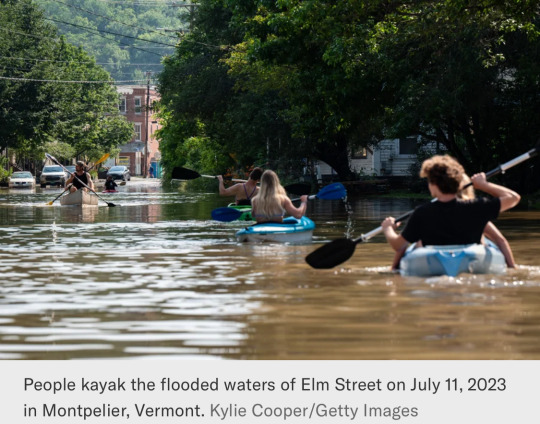
“Legislators in Montpelier are on the brink of enacting the "Climate Superfund Act," modeled after the federal Superfund law, that seeks to make oil, gas and coal companies pay for damages linked to historical greenhouse gas emissions. […] Companies would be held liable for the costs associated with […] floods and heat waves, along with losses to biodiversity, safety, economic development and anything else the treasurer deems reasonable[, that were caused by their emissions].”
3. Important bird habitat now protected in the Rocky Mountain Trench
“Grassland-reliant species in the Rocky Mountain Trench now have more protected habitat thanks to a new [270-hectare] conservation area near Cranbrook. […] About one-third of the Skookumchuck Prairie Conservation Area is forested[…,] Most of the site is a dry grassland[…, and] Three hectares of wetlands add to the landscape diversity and offer crucial benefits to wildlife and water systems in the area. This conservation gem also provides habitat for endangered American badger and excellent winter range for elk, mule deer and white-tailed deer.”
4. Lemur Week marked by 70th breeding success
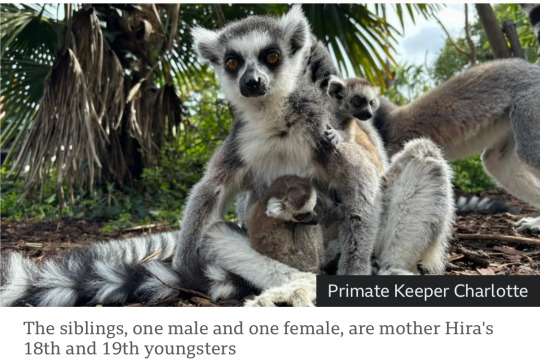
“A wildlife park has celebrated its 70th lemur breeding success ahead of a week raising money to help save the endangered primates. […] The park's open-air Madagascar exhibit is home to 31 free-roaming lemurs and was officially opened in 2008. […] Females are only sexually receptive for just one or two days a year, leaving a small window of opportunity for males to father offspring. […] The two playful siblings, one female and one male, were born to father Bernard and mother Hira.”
5. Innovative material for sustainable building
“Researchers introduce a polymer-based material with unique properties. This material allows sunlight to enter, maintains a more comfortable indoor climate without additional energy, and cleans itself like a lotus leaf. The new development could replace glass components in walls and roofs in the future.”
6. Isle of Wight eagles don't pose threat to lambs as feared

“While there had previously been fears that the eagles would feed on livestock, such as lambs, the project has found no evidence of this. [… “W]hite-tailed eagles effectively steal meals from other predatory birds[, which is] a really important ecological role that had been lost within the landscape and is being restored.” [… The birds’] population was boosted by a chick last year – the first time the species has bred in England in 240 years.”
7. Breakthrough discovery uses engineered surfaces to shed heat
“Cheng's team has found a way to lower the starting point of the [Leidenfrost] effect by producing a surface covered with micropillars. […] The discovery has great potential in heat transfer applications such as the cooling of industrial machines and surface fouling cleaning for heat exchangers. It also could help prevent damage and even disaster to nuclear machinery.”
8. New malaria vaccine delivered for the first time

“A total of 43,000 doses arrived by air today from UNICEF, and another 120,000 are scheduled to show up in the coming days. […] They're the first vaccines designed to work against a human parasite. […] Across four African countries, these trials showed a 75% reduction in malaria cases in the year following vaccination of young children. […] The Serum Institute of India, who will be manufacturing the new vaccine, says a hundred million doses will likely be available to countries by the middle of next year.”
9. Urban gardening may improve human health: Microbial exposure boosts immune system
“"One month of urban indoor gardening boosted the diversity of bacteria on the skin of the subjects and was associated with higher levels of anti-inflammatory cytokines in the blood. The group studied used a growing medium with high microbial diversity emulating the forest soil," [… whereas] the control group used a microbially poor peat-based medium. [… N]o changes in the blood or the skin microbiota were seen. […] “This is the first time we can demonstrate that meaningful and natural human activity can increase the diversity of the microbiota of healthy adults and, at the same time, contribute to the regulation of the immune system."”
10. Cities Are Switching to Electric Vehicles Faster Than Individuals
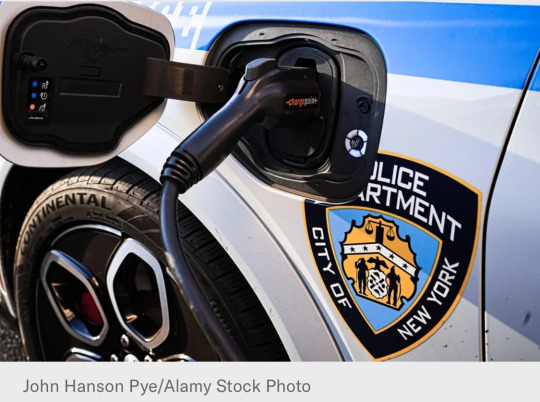
“[M]ost large cities have adopted some kind of climate goal, and some of them are buying EVs for their municipal fleets at a faster rate than the general public. And that progress could speed up as more EVs enter the market and as cities get educated about grant funding and tax incentives that were passed over the last four years.”
May 15-21 news here | (all credit for images and written material can be found at the source linked; I don’t claim credit for anything but curating.)
#hopepunk#good news#chocolate#sustainability#farming#health#vermont#big oil#oil companies#climate change#cooling#technology#nuclear#malaria#vaccine#africa#unicef#eagles#livestock#england#birds#electric vehicles#glass#energy efficiency#habitat#conservation#lemur#zoo#gardening#urban gardening
340 notes
·
View notes
Text




saying some dreams out loud
#junos.art#comic#original art#positivity#climate crisis#original comic#urban planning#gardening#greenspaces#guerilla gardening#climate change#climate solutions#climate action#climate anxiety
32 notes
·
View notes
